Human Orbital Spaceflights
![]()
International Flight No. 208Soyuz TM-29DerbentRussia |
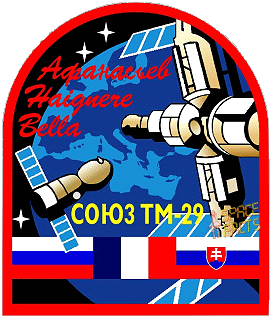 |
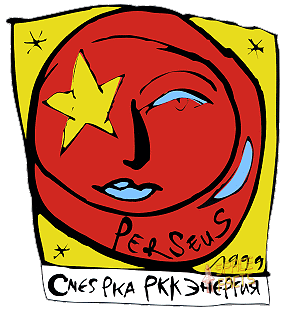 |
![]()
Launch- and landing data
walkout photo |
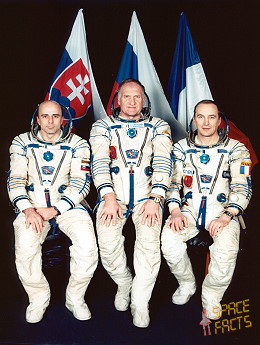 |
|||||||||||||||||||||||
alternative crew photo |
alternative crew photo |
|||||||||||||||||||||||
alternative crew photo |
alternative crew photo |
|||||||||||||||||||||||
alternative crew photo |
alternative crew photo |
|||||||||||||||||||||||
Crew
| No. | Surname | Given names | Position | Flight No. | Duration | Orbits | |
| 1 | Afanasiyev | Viktor Mikhailovich | Commander | 3 | 188d 20h 16m 19s | 2988 | |
| 2 | Haigneré | Jean-Pierre | Flight Engineer | 2 | 188d 20h 16m 19s | 2988 | |
| 3 | Bella | Ivan | Research Cosmonaut | 1 | 7d 21h 56m 19s | 125 |
Crew seating arrangement
|
 |
|
||||||||||||||||
Backup Crew
|
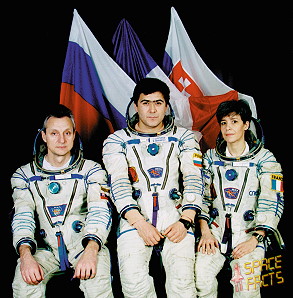 |
||||||||||||||||||||
Hardware
| Launch vehicle: | Soyuz-U (No. M15000-662) |
| Spacecraft: | Soyuz TM-29 (7K-STM No. 78) |
Flight
|
Launch from the Baikonur Cosmodrome and
landing 76 km northnortheast of Arkalyk. Soyuz TM-29 became the first mission under Russian lead with three cosmonauts from three different countries. The new Mir-27 crew consisted of Viktor Afanasiyev as Commander, Sergei Avdeyev as Flight Engineer and French cosmonaut Jean-Pierre Haigneré. Soyuz TM-29 docked with Mir on February 22, 1999 at 05:36 UTC. Since two crew seats had been sold (to Slovakia and France), Viktor Afanasiyev was the only Russian cosmonaut aboard. This meant that Russian Flight Engineer Sergei Avdeyev already aboard Mir would have to accept a double-length assignment. Ivan Bella, executed during his mission the Slovak scientific program Stefanik. This consisted of the following items: Dozimetrie (radiation levels), Senso-asymmetrie (whatever that may be), Endotest (possibly hormonstudies), Metabolism, Training and as they say: Prepelica (Japanese quails). Experiments with these birds have been executed on Mir some years ago; not a single bird survived. He spoke with a specialist on earth and told that he was happy to be able to start with his work. Ivan Bella very quickly had adapted himself to the conditions of weightlessness and that he did not suffer any longer from the headache reported by him during his flight with Soyuz TM-28. Ivan Bella had transported to Mir a number of eggs of that bird in the Incubator-T. The chickens in these eggs were scheduled to come out of the shell during the period of Ivan Bella's stay on board Mir. After arrival Ivan Bella had to transfer the eggs from the Incubator-T to the incubators on board Mir. While doing this he crushed 4 of them, but the other eggs safely were installed in the incubators and the chickens soon came out of their shells. There was a static incubator and one in a slow spinning centrifuge (to create more or less some gravity). Those who saw the light in the first incubator immediately enjoyed life and swallowed food and water. The poor birds who had to grow up in the centrifuge suffered from severe stress due to the darkness and low temperatures. The care for the birds has been taken over by the new crew. The experiment Prepelica is an enhanced continuation of the experiment of that kind executed by Anatoli Soloviyov during his flight. Japanese quails can produce eggs in a high frequency and the birds as will as the eggs are very rich of protein and so very suitable in the food of crews during long duration flights, for instance to Mars and beyond. It was unclear whether a part of the new-born quails would return by Soyuz TM-28. Ivan Bella also executed the other experiments of the Stefanik program. Endotest indeed had something to do with hormone production and the physiology of endocrine glands. For this experiment he had to take blood samples. He also worked on the Dosimetry experiment, which studies the interactions of heavy ions in primary cosmic rays with different materials, i.e. biological tissues, integrated circuits etc. Other experiments were Senso - asymmetry, a study of motion sickness, Trenik (training) to determine the effects on the cardio-vascular system during weightlessness of long and intensive physical training on earth before the flight. The program is named after Milan Ratislav Stefanik, a famous Slovak politician, astronomer, fighter pilot and general of the French army in WW-1, first Czechoslovak Secretary of Defense in the then just independent state. His career was pretty short for he died in a plane crash near Bratislava on May 04, 1919. On February 27, 1999 Mir-26 Commander Gennadi Padalka and Slovak cosmonaut Ivan Bella undocked Soyuz TM-28 from the Kvant rear docking port at 22:52 UTC, landing in Kazakhstan on February 28, 1999 at 02:14 UTC. The French spationaute Jean-Pierre Haigneré felt himself at home and he already started to execute experiments in the framework of the Perseus program. Partly this program is a continuation of items of former Russian-French programs Aragatz, Antares and Altair. He coordinated his activities in this field with French and Russian scientists and specialists in France as well in Russia. During one of his conversations with a Frenchman in Russia he stated that he certainly will use the radio-amateur facilities on board Mir, for instance those installed in the Module Priroda. He also said that there were already arrangements with radio-amateurs in the U.S.A. for ham work during passes over there. Progress M-41 freighter was launched from Baikonur on April 02, 1999 at 11:28:43 UTC. Progress M-41 has 2.5 tons cargo on board consisting of fuel, food, water and scientific research material, mainly for the experiments which Jean-Pierre Haigneré executed in the Perseus program. On board are also 18 live lizards for the Russian-French biological experiment Genesis. It also delivered the Sputnik-99 amateur radio satellite, launched into orbit by hand by the cosmonauts during an EVA. This freighter linked up with the Mir complex on April 04, 1999 at 12:46:49 UTC. The docking was executed in the automatic mode by the system Kurs. The first EVA was conducted by Viktor Afanasiyev and Jean-Pierre Haigneré on April 16, 1999 (6h 19m). Jean-Pierre Haigneré launched by hand the Sputnik-99 amateur radio satellite which was delivered to Mir by Progress M-41. In addition, the cosmonauts installed experiments at the outer surface of the complex and retrieved experiments which had been installed in the past from there. In the night to July 09, 1999 Viktor Afanasiyev and Sergei Avdeyev reported that the SEP (Electrical Power Supply system) in the Module Priroda failed at 21:36 UTC. Lights, ventilators, experiments and the radio amateur equipment in that module failed. Only the computer used by Jean-Pierre Haigneré was still functioning. During all following passes that night and the passes during the following night there was no radio traffic, so no follow up about this problem. Possibly the crew restored the power supply in Priroda. The launch of freighter Progress M-42 took place from Baikonur on July 16, 1999 at 16:37:33 UTC. Progress M-42 had to deliver to Mir 2.5 tons cargo among which water, fuel, food, mail, some experiments, a reflector antenna, which has to be installed outside the complex during a spacewalk and a guiding system to enable TsUP to control the complex remote controlled during unmanned status. Progress M-42 docked with the Kvant port at 17:53 UTC on July 18, 1999. It remained docked to the station after the departure of the last operational crew in September 1999. The vessel undocked on February 02, 2000, to clear the port for Progress M1, at 03:11:52 UTC. The freighter was deorbited over the Pacific later the same day at 06:10:40 UTC with an 8-minute burn. Viktor Afanasiyev and Sergei Avdeyev performed a second EVA on July 23, 1999 (6h 07m). The cosmonauts installed a new experimental 6-meter antenna but failed to deploy it. Viktor Afanasiyev was only able to open the antenna for 80 or 90%. In addition, during the EVA the cosmonauts had to retrieve some experiments from the outer surface. They succeeded to do so with the experiments Exobiology and Dvikon. The EVA ended in a great hurry due to a failure of the thermoregulation in the spacesuit of Viktor Afanasiyev. A filter was overheated. A third and final EVA was performed by Viktor Afanasiyev and Sergei Avdeyev on July 28, 1999 (5h 22m). This time the unfolding of the antenna was successful. The first task was to resume the attempts to achieve the full deployment of the Georgian-Russian reflector antenna. This was a success. The enormous antenna, a little bit looking like an ellipse, has a diameter between 6.4 and 5.2 meters. The experiment was just an engineering operation to test a new system for the antenna deployment by remote control. In the future this system has to be implemented for antennae used on navigation satellites. As soon as everybody was convinced that the system was able to be used flawlessly, the antenna was disconnected and pushed away for a short autonomous flight in space. Not without showing some pride, the Georgian specialists stated that this was the launch of the 1st Georgian sputnik. They installed the experiments Indicator and Sprut-4 and changed the cassettes of the Migmas ion spectrometer. They also retrieved some experiments from the outside of the complex, i.e. the Danko-M and the Ekran-D frame. During a radio-amateur conversation on July 30, 1999 at 14:50 UTC Jean-Pierre Haigneré said that they had a minor problem with the attitude control of the station, but that all was well and he expected that the problem would soon be solved. TsUP gave Viktor Afanasiyev computer commands related to the correction of the attitude with the use of steering rockets and the VDU thruster, and in that way restoring the efficiency of the solar batteries. One orbit later at 19:35 UTC TsUP told Sergei Avdeyev that he could use the means of the 'ship' (Soyuz TM-29) to secure the power supply. The cause of the computer failure was a wrong command from TsUP. The crew was not very impressed and apart from the operation to restore the functioning of the gyrodynes. The Soyuz spacecraft is composed of three elements attached end-to-end - the Orbital Module, the Descent Module and the Instrumentation/Propulsion Module. The crew occupied the central element, the Descent Module. The other two modules are jettisoned prior to re-entry. They burn up in the atmosphere, so only the Descent Module returned to Earth. The deorbit burn lasted about 240 seconds. Having shed two-thirds of its mass, the Soyuz reached Entry Interface - a point 400,000 feet (121.9 kilometers) above the Earth, where friction due to the thickening atmosphere began to heat its outer surfaces. With only 23 minutes left before it lands on the grassy plains of central Asia, attention in the module turned to slowing its rate of descent. Eight minutes later, the spacecraft was streaking through the sky at a rate of 755 feet (230 meters) per second. Before it touched down, its speed slowed to only 5 feet (1.5 meter) per second, and it lands at an even lower speed than that. Several onboard features ensure that the vehicle and crew land safely and in relative comfort. Four parachutes, deployed 15 minutes before landing, dramatically slowed the vehicle's rate of descent. Two pilot parachutes were the first to be released, and a drogue chute attached to the second one followed immediately after. The drogue, measuring 24 square meters (258 square feet) in area, slowed the rate of descent from 755 feet (230 meters) per second to 262 feet (80 meters) per second. The main parachute was the last to emerge. It is the largest chute, with a surface area of 10,764 square feet (1,000 square meters). Its harnesses shifted the vehicle's attitude to a 30-degree angle relative to the ground, dissipating heat, and then shifted it again to a straight vertical descent prior to landing. The main chute slowed the Soyuz to a descent rate of only 24 feet (7.3 meters) per second, which is still too fast for a comfortable landing. One second before touchdown, two sets of three small engines on the bottom of the vehicle fired, slowing the vehicle to soften the landing. Following an extended mission and three spacewalks, the last operational crew aboard Mir prepared to return. The station was powered down and prepared for free drift mode. The hatch between Mir and Soyuz was closed for the last time at 18:12 UTC on August 27, 1999. Soyuz TM-29 undocked from Mir at 21:17 UTC with Viktor Afanasiyev, Sergei Avdeyev and Jean-Pierre Haigneré aboard. The Mir-27 crew landed in Kazakhstan on August 28, 1999. Viktor Afanasiyev had set a new cumulative time in space record, but for the first time since September 1989 there were no humans in space. The only crew that might return to Mir would be one to deorbit it, and beyond that budgets indicated that no more than one Soyuz crew per year could be sent to the International Space Station. |
EVA data
| Name | Start | End | Duration | Mission | Airlock | Suit | |
| EVA | Haigneré, Jean-Pierre | 16.04.1999, 04:37 UTC | 16.04.1999, 10:56 UTC | 6h 19m | Soyuz TM-29 | Mir - Kvant2 | Orlan-M No. 4 |
| EVA | Afanasiyev, Viktor | 16.04.1999, 04:37 UTC | 16.04.1999, 10:56 UTC | 6h 19m | Soyuz TM-29 | Mir - Kvant2 | Orlan-M No. 5 |
| EVA | Avdeyev, Sergei | 23.07.1999, 11:06 UTC | 23.07.1999, 17:13 UTC | 6h 07m | Soyuz TM-29 | Mir - Kvant2 | Orlan-M No. 4 |
| EVA | Afanasiyev, Viktor | 23.07.1999, 11:06 UTC | 23.07.1999, 17:13 UTC | 6h 07m | Soyuz TM-29 | Mir - Kvant2 | Orlan-M No. 6 |
| EVA | Avdeyev, Sergei | 28.07.1999, 09:37 UTC | 28.07.1999, 14:59 UTC | 5h 22m | Soyuz TM-29 | Mir - Kvant2 | Orlan-M No. 4 |
| EVA | Afanasiyev, Viktor | 28.07.1999, 09:37 UTC | 28.07.1999, 14:59 UTC | 5h 22m | Soyuz TM-29 | Mir - Kvant2 | Orlan-M No. 6 |
Note
Photos / Graphics
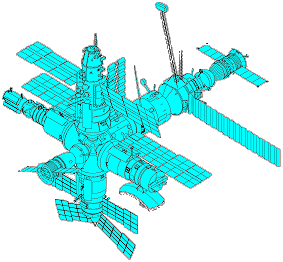 |
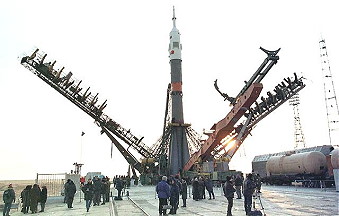 |
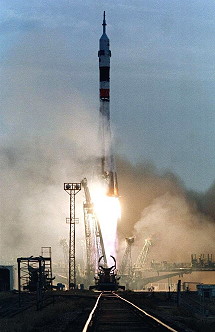 |
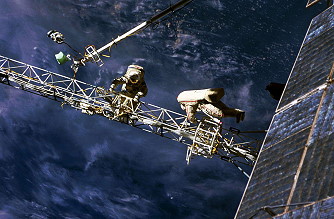 |
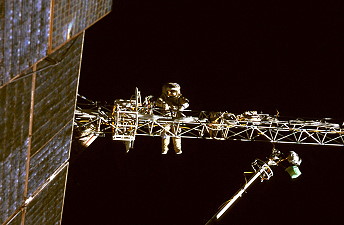 |
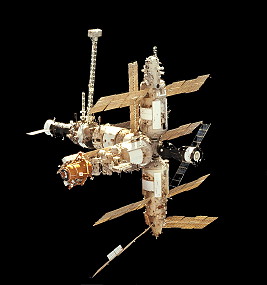 |
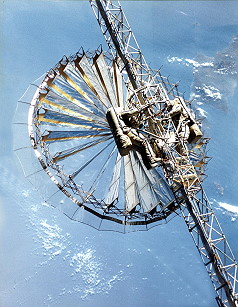 |
 |
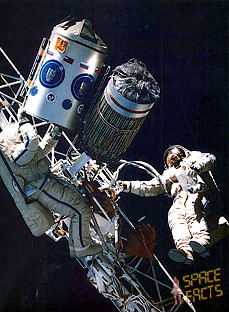 |
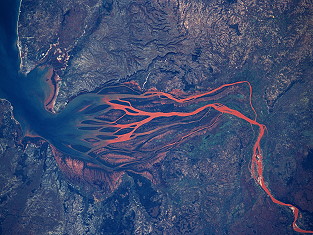 |
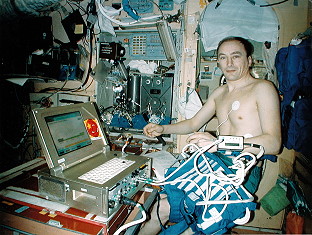 |
 |
 |
 |
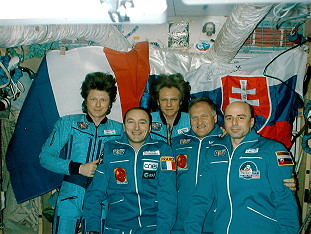 |
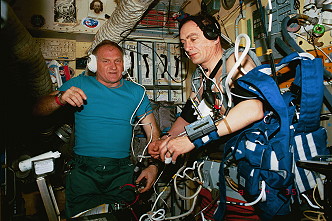 |
 |
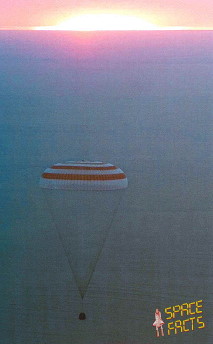 |
 |
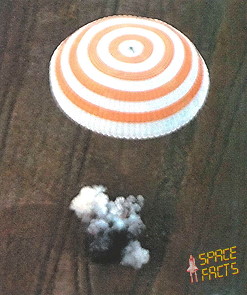 |
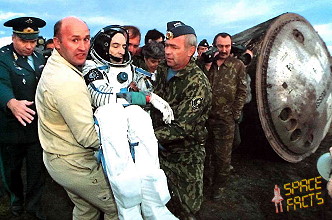 |
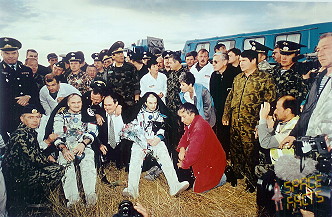 |
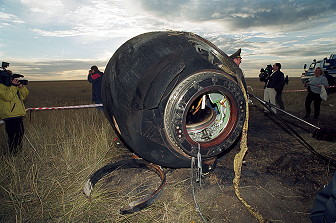 |
|
more Earth observation photos |
|
more EVA photos |
|
| © |  |
Last update on Septemver 04, 2021.  |
 |